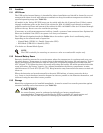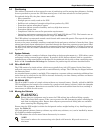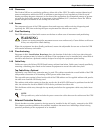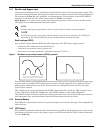
Single Module UPS Installation
5
1.4 Positioning
The cabinet is mounted on four casters for ease of positioning and for moving short distances. Jacking
feet are provided to prevent the UPS from moving once it has been wheeled to its final position.
For optimal design life, the place chosen must offer:
•Easy connection
• Enough space to easily work on the UPS
• Sufficient air exchange of enough to dispel heat produced by UPS
• Protection against atmospheric agents
• Protection against excessive humidity and very high heat sources
• Protection against dust
• Compliance with the current fire prevention requirements
• Operating environment temperature between 20°C and 25°C (68 and 77°F). The batteries are at
maximum efficiency in this temperature range (see Table 33).
The UPS cabinet is constructed around a steel chassis with removable panels. The top and side panels
are secured to the chassis by screws.
Access to the power terminals, auxiliary terminals blocks and power switches is from the front. Oper-
ational status and alarm information is provided through the front door operator control panel. Mod-
els 40kVA and below house both the power components and an internal battery. Cooling air enters in
the front of the NXa 30-120kVA and the front and bottom of NXa 140-200kVA; it is exhausted out the
top of each.
1.4.1 System Cabinets
A UPS may comprise a number of cabinets, depending on design requirements (e.g., UPS cabinet, exter-
nal battery cabinet, external bypass cabinet). In general, all the Liebert cabinets used in a particular
installation are of the same height and designed to be positioned side-by-side to form a matching array.
Refer to 5.0 - Installation Drawings for assistance on positioning the cabinets described below.
1.4.2 30 to 40kVA UPS
The UPS consist of a single cabinet, which uses typically forty (40) 12V battery blocks, fitted inter-
nally and connected in series to provide a nominal battery voltage.
The UPS may be shipped without
the batteries fitted.
An extended battery option is available. This comprises a separate cabinet containing additional bat-
teries that can be connected to the UPS to increase its battery run time. Battery cabinets and batter-
ies are usually shipped separately.
1.4.3 60-200kVA UPS
The 60 to 200kVA consist of a single cabinet without any internal battery. Usually, with 60 to 200kVA
UPS installations, the batteries are contained in a purpose-built battery cabinet, which sits alongside
the main UPS equipment. Batteries are accessible in the external cabinet from the front, making it
unnecessary to allow for side access.
1.4.4 Moving the Cabinets
Ensure that the UPS weight is within the designated surface weight loading of any handling equip-
ment. See Table 35.
UPS and optional cabinets (battery cabinets, top cable entry cabinets, etc.) can be handled by means
of a forklift or similar equipment.
The UPS cabinet also can be moved short distances by its casters.
!
WARNING
Ensure that any equipment used to move the UPS cabinet has sufficient lifting capacity.
The UPS is fitted with casters. Take care to prevent the NX from moving when unbolting the
unit from its shipping pallet. Ensure that adequate personnel and lifting aids are available
when removing the shipping pallet.
NOTE
Care must be taken when maneuvering units fitted with batteries. Keep such moves to a
minimum.


















